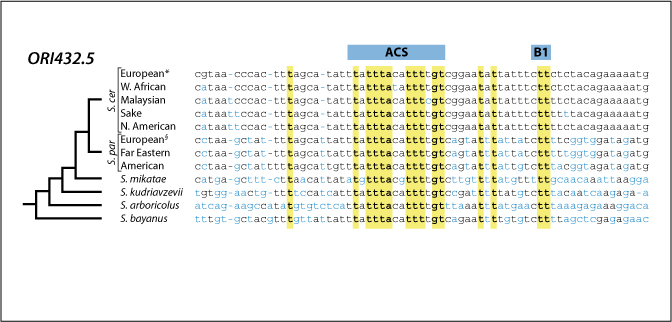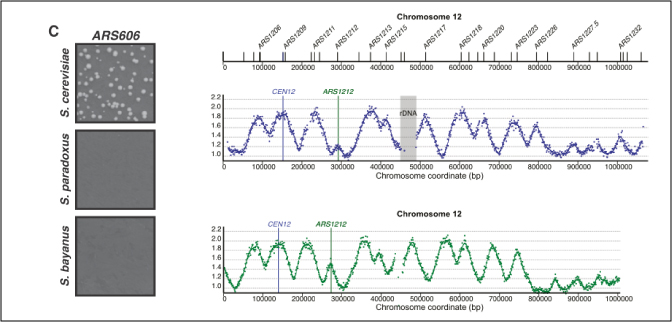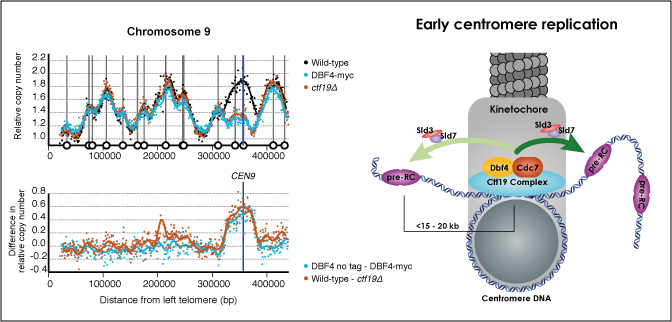Regulating genome replication in time and space
Click images to discover more.
All cells contain a complete copy of the organism's DNA, the genetic blueprint of life, packaged into discrete units called chromosomes. Since new cells need a copy of the genetic material, the chromosomes must be completely and accurately replicated before the cell can divide. Eukaryotes, such as yeast and people, have large genomes with millions of bases encoding the genetic information. To ensure complete replication of these genomes within the allowed time, the process of DNA replication starts at multiple sites along each chromosome, called replication origins. These replication origins are specialised DNA sequences that assemble the cellular machinery that then moves along the DNA, reading and copying the genetic material. It is essential that the cell activates sufficient replication origins to ensure complete replication of the chromosomes. The importance of controlling replication origin activation is highlighted by the genome instability and diseases that may result from uncontrolled chromosome replication. Despite the importance of DNA replication origins we understand little about the DNA sequences that specify and control them. Failures in the processes of DNA replication lead to genetic instability and diseases such as cancer and congenital disorders. In the future, a better understanding of the basic biology that ensures genetic integrity will give new insights that will allow improved diagnosis and treatment of these diseases.
Complete, accurate replication of the genome is essential for life. Eukaryotes, including yeast and humans, have large genomes with millions of bases encoding the genetic information. To ensure complete replication of these genomes within the allowed time, the process of DNA replication starts at multiple sites along each chromosome, called replication origins. These replication origins are specialised DNA sequences that assemble the cellular machinery that then moves along the DNA reading and copying the genetic material. It is essential that the cell activates sufficient replication origins to ensure complete replication of the chromosomes. The importance of controlling replication origin activation is highlighted by the genome instability that may result from uncontrolled chromosome replication. Despite the importance of DNA replication origins we understand little about the DNA sequences that specify and control them. Failures in the processes of DNA replication lead to genetic instability and diseases such as cancer and congenital disorders.
We aim to understand how genome replication is regulated; our focus is on the control of replication initiation. Specific questions include:
How are replication initiation sites ('origins') selected?
How are differences in replication initation time regulated?
Why do different regions of the genome replicate at particular times?
We use a mixture of classical genetic, cutting-edge genomic and systems biology approaches. The processes of genome replication are highly conserved between yeasts and man. Primarily we use the model eukaryote, Saccharomyces cerevisiae (brewers or budding yeast), due to the range of powerful technologies available. Valuable insights also have been offered by comparisons between related species, an approach called 'comparative genomics'.
Our recent publications
DNA replication timing influences gene expression level.
Müller & Nieduszynski (2017)
J. Cell Biol., 216(7):1907-1914
Deep functional analysis of synII, a 770-kilobase synthetic yeast chromosome.
Shen et al. (2017)
Science, 355(6329):
Discovery of an Unconventional Centromere in Budding Yeast Redefines Evolution of Point Centromeres.
Kobayashi et al. (2015)
Curr. Biol., 25(15):2026-33
A global profile of replicative polymerase usage.
Daigaku et al. (2015)
Nat. Struct. Mol. Biol., 22(3):192-8
The dynamics of genome replication using deep sequencing.
Müller et al. (2014)
Nucleic Acids Res., 42(1):e3







